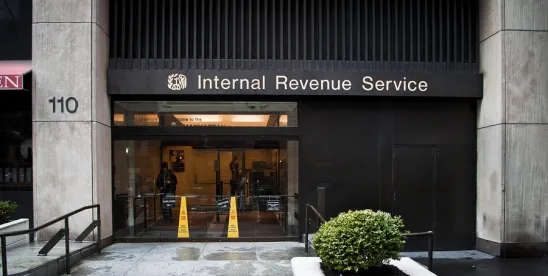On 28 August 2020, the IRS issued eagerly awaited guidance on the implementation of the employee FICA payroll deferral authorized in a Presidential Memorandum (the Memorandum) signed by President Trump on 8 August 2020.1Notice 2020-65, “Relief with Respect to Employment Tax Deadlines Applicable to Employers Affected by the Ongoing Coronavirus (COVID-19) Disease 2019 Pandemic,” defines key terms and provides very basic information on executing the Memorandum, but leaves open many details that will affect whether employers decide to participate in the deferral.
Signed as part of a suite of executive guidance in response to COVID-19 to provide temporary relief to Americans, the Memorandum institutes the deferral (not forgiveness) of withholding and payment of the employee share of FICA taxes during the period 1 September 2020 through 31 December 2020. It applies to employees generally paid wages or compensation of less than $4,000 on a bi-weekly basis. Additional details are left to the Secretary of the Treasury who is instructed in the Memorandum to provide additional guidance regarding the mechanics of the deferral. Notice 2020-65 (the “Notice”) was issued three days prior to the intended effective date of the deferral, leaving employers little time to decide as to whether to participate - a decision making process made more difficult since the Notice leaves many questions about the terms of implementation and the collection of the deferred taxes unanswered.
This alert first describes the terms in the Notice and then considers many of the lingering questions concerning the deferral that employers must consider when making a decision about participation. Note that given the short lead time between 28 August and the 1 September effective date there is a sense of urgency and many employers will not be able to update their systems and notify employees in time to timely implement the deferral, yet another scenario not contemplated in the Notice.
TERMS OF IMPLEMENTATION
Following are the terms of implementation of the payroll deferral as described in Notice 2020-65:
At a Glance
An “Affected Taxpayer” (employer) may defer the withholding and payment of “Applicable Taxes” (employee share of FICA) on “Applicable Wages” (less than $4,000 paid per bi-weekly pay-period) from 1 September 2020 through 31 December 2020. The deferred taxes must be ratably withheld and paid beginning 1 January 2021 and ending 30 April 2021.
Who is an Affected Taxpayer?
An Affected Taxpayer is an employer required to withhold and pay the employee share of social security taxes (or equivalent railroad retirement taxes).
What Payroll Taxes can be Deferred (Applicable Taxes)?
Applicable Taxes subject to deferral are an employee’s share of social security taxes (FICA) on eligible wages or compensation (Applicable Wages) paid to the employee on a pay date during the period beginning on 1 September 2020 and ending on 31 December 2020.
What are Applicable Wages?
Applicable Wages are wages and compensation paid to an employee in an amount less than $4,000 on a bi-weekly basis (or an equivalent threshold if the pay period is shorter or longer than bi-weekly). This threshold will be determined on a payroll period by payroll period basis.
What Constitutes “Wages or Compensation” for Purposes of Determining Applicable Wages?
“Wages” and “compensation” are defined under Code Sections 3121(a) and 3231(e), respectively, and are the only amounts that are considered in determining whether the threshold is reached. This means an employee could receive other types of remuneration (i.e., certain health and pension benefits) that would place the total value of remuneration above the $4,000 bi-weekly income threshold but would not be counted toward Applicable Wages.
When are Applicable Taxes due?
The due date for withholding and payment of Applicable Taxes to the IRS is postponed until a period beginning 1 January 2021 and ending on 30 April 2021. The Memorandum and Notice only provide deferment of the Applicable Taxes, and do not provide a tax holiday or forgiveness of the amounts due.
How are the Applicable Taxes Paid When the Deferral Period Ends?
Between 1 January 2021 and 30 April 2021, an Affected Taxpayer must ratably withhold from employees and pay to the IRS the Applicable Taxes. If necessary, an Affected Taxpayer may make other arrangements for collecting Applicable Taxes due from the employee. If the full amount of Applicable Taxes is not withheld and paid by 30 April 2021, interest, penalties, and additions to tax will begin to accrue on unpaid amounts beginning 1 May 2021.
UNANSWERED QUESTIONS AND LINGERING CONCERNS
Are Affected Taxpayers Required to Defer the Applicable Taxes?
Apparently not. While the Notice does not address whether participation is mandatory or voluntary for employers, Administration officials have publicly and repeatedly stated that participation is not mandatory and the Notice does not expressly require Affected Taxpayers to participate. If an employer chooses not to participate, it is unclear whether the IRS may consider withholding and payment of the Applicable Taxes before the end of the deferral period as an “advance payment.” If the IRS does attribute such meaning to non-participating employers, such employers and the IRS may be required to follow special procedures to account for the payments until they become due or assessed, thereby creating additional administrative burdens.
May Employees Opt-in or Opt-out of Deferral?
The Notice does not address whether employees are allowed to insist the employer participate in deferral nor whether an employee can opt-out if the employer does participate in the deferral.
What Issues Does the $4,000 Threshold Create?
The threshold could create significant complexities and uncertainty for employees and employers alike, resulting in inequities among employees, employee confusion and dissatisfaction, and additional burdens on the part of employers. These include:
- The threshold applies on the cash basis and not an accrual basis, and without a phase-in or phase-out, making it an all-or-nothing benefit with employees making $1 over the threshold receiving no deferral.
- Because an employee’s wages can fluctuate due to overtime, bonuses, seasonal hours, or other flexible work schedules, some pay periods may qualify for deferral and others may not, potentially resulting in disparate treatment for the same employee across pay periods and among employees within a single organization.
- Employees receiving cash remuneration in lieu of benefits and those receiving employer-provided benefits may be treated differently, as the extra cash may put employees over the threshold even though they use the funds to pay for insurance or a retirement plan.
- It is unclear how employees working for more than one employer making under the threshold at each employer but above the threshold cumulatively will be treated, or how tips will be handled to determine if the threshold is reached.
- From the employer’s perspective, modifying IT in a timely manner to correctly identify Applicable Wages in each pay period and to accurately track deferred amounts, and to be able to reverse the process in a few months, will be costly and resource intensive.
- To accurately track both deferred and collected amounts, employers likely will be subject to additional information reporting on employment tax returns and Forms W-2 issued to employees and the IRS. This might include amounts that could have been deferred by an employer choosing not to participate in case Congress eventually approves legislation forgiving the deferred amounts in order to treat all employees similarly and equitably.
- Assuming not all employers participate, some employees may receive the extra cash flow now while friends and family members others do not; however, employees benefiting now will experience less cash flow beginning in January as the Applicable Taxes are paid. To try to avoid unhappy employees on both ends of the continuum, employers will need to educate employees on the process and their liability to repay the deferred amounts. Unions and trade associations also may play a role in this process.
HOW DOES AN AFFECTED TAXPAYER COLLECT APPLICABLE TAXES WHEN AN EMPLOYEE’S EMPLOYMENT TERMINATES BEFORE 30 APRIL 2021?
The Notice does not specifically discuss situations where an employee terminated after withholding has been deferred, but prior to the entire deferred amount being collected. The Notice seems to anticipate that scenario by authorizing employers to “make other arrangements to otherwise collect the total Applicable Taxes from the employee.” It is unclear whether the IRS expects the employer to take legal action to collect from the former employee or otherwise be required to pay that person’s share of deferred taxes.
If the Full Amount of Applicable Taxes is Not Withheld and Paid by the Employer to the IRS by 30 April 2021, could the IRS Collect Deferred Taxes Directly from the Employee?
The Notice does not discuss whether an employee could be held personally accountable for payment. This could occur if the employee no longer was employed by the employer (i.e., voluntarily left, was furloughed or fired, was injured, or was a seasonal employee), the employer went out of business and no longer exists, or the employer did not correctly withhold and pay the deferred taxes in a timely manner. For the IRS to have this information presumes the employer has provided the necessary information through information reporting on the employment tax returns and/or the Form W-2. If the employee did not voluntarily pay, would the IRS use its offset authority to take the deferred taxes out of the employee’s tax refund?
How Does the Guidance Affect Self-Employed and Household Employees?
The Notice does not address how self-employed individuals and household employers can implement the deferral. Regarding payment, the recently released draft Year 2020 Form 1040, Schedule 3, includes a line item for the self-employed and household employers to remit the deferred amounts when filing their 2020 tax returns.
What Happens if an Employer Decides to Participate but Cannot Be Ready by 1 September 2020?
The Notice does not address this situation. Perhaps the employer would have two options, the first being a retroactive reduction in withholding and the second allowing the employer to begin when IT systems are in place. Given the number of outstanding questions and concerns about the program, it seems probable that the IRS could issue Frequently Asked Questions to address these issues.
Will the Deferred Taxes Be Forgiven?
This is a political and policy question that is unlikely to be answered in time to help employers make their decisions about whether to participate. While there has been some controversy over whether President Trump had the authority to implement the payroll tax deferral under the purview of the disaster provisions of the Stafford Act, it is almost universally agreed that only Congress can authorize forgiveness. Since putting their employees in a position where they are accumulating a significant payable to the government is a primary reason why many employers are not participating in the deferral, knowing that the taxes would eventually be forgiven would probably swing those decisions. The President has stated he intends to pursue such legislation if he wins reelection, but it is unclear whether a mixed Congress under that scenario would approve such a measure, or whether a White House and/or Congress controlled by Democrats would approve it, either. The impact on the national debt as well as the effect on the Social Security Trust Fund will be factors for lawmakers to consider. However, whether Republicans or Democrats control Washington in January 2020, it will be difficult to watch employees deal with the hit on their cash flow when both the regular withholding and catch-up payments kick in. This could have ripple effects on a still-recovering economy, as well.
DECIDING WHETHER TO PARTICIPATE
Now that 1 September has arrived, employers will need to make a quick decision on whether or not to participate in the payroll deferral. Thorough consideration of the program, including the issues addressed in this alert, will be important in helping employers make the best decision for their business and their employees. Please contact any of the authors of this alert if you have questions about the implementation of the payroll deferral and how the Memorandum and Notice may apply to your business’ particular facts and circumstances.
1 On 8 August 2020, President Trump issued a Presidential Memorandum directing the Secretary of the Treasury to use his authority pursuant to Internal Revenue Code Section 7508A to defer the withholding, deposit, and payment of certain payroll tax obligations. The Presidential Memorandum is available here.






 />i
/>i

